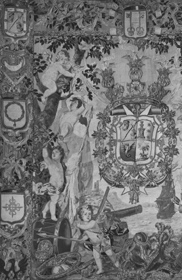Study Images of Tapestries

|
|
The Research Library's Photo Archive includes photographs of over 5,000 medieval and early modern tapestries from European and American collections. The descriptive catalog records in the Photo Archive Database have recently been augmented by over 4,000 digital images of these tapestries. All catalog records are available on the Internet via the Photo Archive Database. Access to digital images is provided where the J. Paul Getty Trust holds copyright.
The study photographs—many of which are historic in nature—constitute one of the few comprehensive visual resources for the study of tapestries. Most of the images represent tapestries of the late 15th to the late 18th century: Southern Netherlands (pre–1528), Flemish (including the important Brussels production and the products of smaller centers, such as Arras, Bruges, and Tournai), Dutch, and French (workshops preceding the establishment of the royal factories in the 17th century, followed by the production of the Gobelins, Beauvais, and Aubusson factories). English, German, and Italian tapestries, though less numerous, are present with important sets. Adolph S. Cavallo and Thomas Campbell provided expert identifications for cataloging.
Sources of the Tapestries Images
The photographs were acquired from a variety of sources. Some were purchased directly from museums, image vendors, and auction houses, while others were taken from dealer and scholar archives that are now housed in the Research Library. Approximately half the holdings are constituted by the French and Company photographs, 1915–1988. Soon after the New York firm entered the art market in 1907, it acquired and photographed the Charles M. Ffoulke collection, which includes tapestries from the Barberini holdings. The French and Company stock from 1907 through the 1960s is comprehensively documented in the firm's business archive, which includes information on provenance, bibliography, restorations, and prices.
The George Leland Hunter manuscripts, notes, and ephemera represent another significant source of historic photographs. Hunter, the tapestries expert and author of the classic Practical Book of Tapestries (1925), kept copious notes and acquired numerous photographs of many major tapestries, including images of tapestries that once adorned the Spanish royal palaces and are now part of the Patrimonio Nacional.